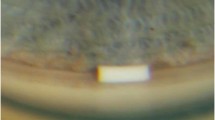Abstract
Timolol eyedrops may cause systemic side-effects in glaucoma patients due to absorption of the drug into systemic circulation. In a previous study, timolol concentrations in plasma were reduced if timolol was administered in ocular inserts instead of eyedrops. We compared the intraocular pressure lowering effect and systemic absorption of timolol inserts to those of 0.5 % timolol eyedrops in humans. Inserts of silicone tubing released 90.3 ± 13.9 µg of timolol in 24 hours in vivo. Timolol inserts afforded similar decreases in intraocular pressure in open-angle glaucoma patients as did b.i.d. eyedrops, but produced lower peak timolol concentrations in plasma, 0.70 ± 0.10 ng/ml and 0.24 ± 0.05 ng/ml, respectively. After eyedrops, peak concentrations were achieved at 15.0 ± 2.2 min, while application of an insert resulted in a delayed peak (tmax = 623 ± 195 min). The insert resulted in a higher systemically absorbed fraction of the timolol dose than the eyedrop, but the peak timolol concentration and daily absorbed amount of timolol were decreased. The release rate of timolol from the inserts in vivo was only slightly less than that in vitro. Silicone devices are useful for clinical testing of controlled delivery properties of ocular drugs.
Similar content being viewed by others
References
W.P. Munroe, J.P. Rindone, R.M. Kershner. Systemic side effects associated with the ophthalmic administration of timolol. Drug Intell. Clin. Pharm. 19: 85–89 (1985).
A. Urtti and L. Salminen. Minimizing systemic absorption of topically administered ophthalmic drugs. Surv. Ophthalmol. 37: 435–456 (1993).
W.L. Nelson, F.T. Fraunfelder and J.M. Sills. ADverse respiratory and cardiovascular events attributed to timolol ophthalmic solution, 1978–1985. Am. J. Ophthalmol. 102: 606–611 (1986)
S.C. Chang, H. Bundgaard, A. Buur and V.H.L. Lee. Improved corneal penetration of timolol by prodrugs as a means to reduce systemic drug load. Invest. Ophthalmol. Vis. Sci. 28: 487–491 (1987).
K. Kyyrönen and A. Urtti. Improved ocular:systemic absorption ratio of timolol by viscous vehicle and phenylephrine. Invest. Ophthalmol. Vis. Sci. 31:1827–1833 (1990).
A. Urtti, J.D. Pipkin, G.S. Rork, T. Sendo, U. Finne and A.J. Repta. Controlled drug delivery devices for experimental ocular studies with timolol. 2. Ocular and systemic absorption in rabbits. Int. J. Pharm. 61: 241–249 (1990).
M.S. Passo, E.A. Palmer and E.M. Van Buskirk. Plasmal timolol in glaucoma patients. Ophthalmol. 91: 1361–1363 (1984).
T. Kaila, R. Huupponen and L. Salminen. Effects of eyelid closure and nasolacrimal duct occlusion on the systemic absorption of ocular timolol in human subjects. J. Ocul. Pharmacol. 2: 365–369 (1986).
S. Ohdo, G.M. Grass and V.H.L. Lee. Improving the ocular to systemic ratio of topical timolol by varying the dosing time. Invest. Ophthalmol. Vis. Sci. 32: 2790–2798 (1991).
A. Urtti, J.D. Pipkin, G. Rork and A.J. Repta. Controlled drug delivery devices for experimental ocular studies with timolol. 1. In vitro release studies. Int. J. Pharm. 61: 235–240 (1990).
T. Kaila. A sensitive radioligand binding assay for timolol in plasma. J. Pharm. Sci. 80: 296–299 (1991).
L.Z. Benet and R.L. Williams. Design and optimization of dosage regimens: pharmacokinetic data. In A. Goodman Gilman, T.W. Rall, A.S. Nies, P. Taylor (eds.), The Pharmacological Basis of Therapeutics. Pergamon Press, New York, 1990, pp. 1650–1735.
D.M. Maurice and S. Mishima. Ocular pharmacokinetics. In M.L. Sears (ed.), Handbook of Experimental Pharmacology vol 69, Pharmacology of the Eye, Springer-Verlag, Berlin-Heidelberg, 1984, pp. 19–116.
J.J. Hurwitz, M.N. Maisey and R.A.N. Welham. Quantitative lacrimal scintillography. I. Method and physiological application. Br. J. Ophthalmol. 59: 308–312 (1975).
J.J. Hurwitz, M.N. Maisey and R.A.N. Welham. Quantitative lacrimal scintillography. II. Lacrimal pathology. Br. J. Ophthalmol. 59: 313–322 (1975).
J.G. Hardy, S.W. Lee and C.G. Wilson. Intranasal drug delivery by spray and drops. J. Pharm. Pharmacol. 37: 394–297 (1985).
S.C. Chang and V.H.L. Lee. Nasal and conjunctival contributions to the systemic absorption of topical timolol in the pigmented rabbit: implications in the design of strategies to maximize the ratio of ocular to systemic absorption. J. Ocul. Pharmacol. 3:159–167 (1987).
A. Urtti. Simulation of the absorptive membrane permeability effects on in vivo drug release from controlled release systems. Proc. Intern. Symp. Control. Rel. Bioact. Mater. 18: 431–432 (1991).
R. Guy and J. Hadgraft. Rate control in transdermal drug delivery? Int. J. Pharm. 82: R1–R4 (1992).
Author information
Authors and Affiliations
Rights and permissions
About this article
Cite this article
Urtti, A., Rouhiainen, H., Kaila, T. et al. Controlled Ocular Timolol Delivery: Systemic Absorption and Intraocular Pressure Effects in Humans. Pharm Res 11, 1278–1282 (1994). https://doi.org/10.1023/A:1018938310628
Issue Date:
DOI: https://doi.org/10.1023/A:1018938310628




